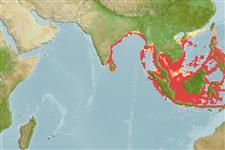Common names from other countries
>
Eupercaria/misc (Various families in series Eupercaria) >
Nemipteridae (Threadfin breams, Whiptail breams)
Etymology: Nemipterus: Greek, nema, -atos = filament + Greek, pteron = wing, fin (Ref. 45335).
More on author: Bleeker.
Environment: milieu / climate zone / depth range / distribution range
Ecologia
marinhas demersal; não migratória; intervalo de profundidade ? - 75 m (Ref. 9785). Tropical; 23°N - 9°S, 78°E - 126°E (Ref. 3810)
Indo-West Pacific: including the Bay of Bengal, Andaman Sea, Strait of Malacca, Philippines, South China Sea, Gulf of Thailand and Indonesia. Record from northwestern Australia is apparently unfounded.
Tamanho / Peso / Idade
Maturity: Lm ? range ? - ? cm
Max length : 20.0 cm SL macho/indeterminado; (Ref. 3810); common length : 15.0 cm SL macho/indeterminado; (Ref. 3810)
Espinhos dorsais (total) : 10; Raios dorsais moles (total) : 9; Espinhos anais: 3; Raios anais moles: 7. Suborbital spine absent. Preopercle with 3 transverse scale rows. Pectoral and pelvic fins long, reaching to between level of anus and origin of anal fin. First two dorsal spines close together, almost fused, forming a very long filament. Upper lobe of caudal fin produced to form a trailing filament. A line drawn up from the posterior edge of suborbital reaching the dorsal profile about 2 to 5 scale rows before origin of dorsal fin. Axillary scale present. Color: Head and body pinkish, silvery-white below.
Occurs on sand or mud bottoms.
Life cycle and mating behavior
Maturities | Reprodução | Spawnings | Egg(s) | Fecundities | Larvas
Russell, B.C., 1990. FAO Species Catalogue. Vol. 12. Nemipterid fishes of the world. (Threadfin breams, whiptail breams, monocle breams, dwarf monocle breams, and coral breams). Family Nemipteridae. An annotated and illustrated catalogue of nemipterid species known to date. FAO Fish. Synop. 125(12):149p. Rome: FAO. (Ref. 3810)
Categoria na Lista Vermelha da IUCN (Ref. 130435)
CITES (Ref. 128078)
Not Evaluated
Ameaça para o homem
Harmless
Utilização humana
Pescarias: pouco comercial
Ferramentas
Relatórios especiais
Descarregue XML
Fontes da internet
Estimates based on models
Preferred temperature (Ref.
115969): 27.7 - 29.2, mean 28.7 (based on 784 cells).
Phylogenetic diversity index (Ref.
82804): PD
50 = 0.5000 [Uniqueness, from 0.5 = low to 2.0 = high].
Bayesian length-weight: a=0.01380 (0.01151 - 0.01656), b=2.96 (2.93 - 2.99), in cm Total Length, based on LWR estimates for this species (Ref.
93245).
Nível Trófico (Ref.
69278): 3.8 ±0.5 se; based on size and trophs of closest relatives
Resiliência (Ref.
120179): Elevada, tempo mínimo de duplicação da população menor que 15 meses (K=0.4-0.9).
Fishing Vulnerability (Ref.
59153): Low vulnerability (24 of 100).
